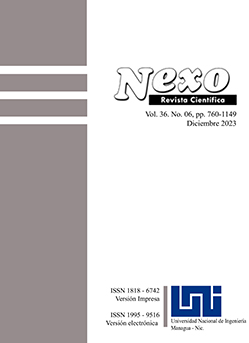Synthesis and characterization of ZNO: CU and AG bimetallics nanoparticles by sol gel method
DOI:
https://doi.org/10.5377/nexo.v36i06.17466Keywords:
Cu-Ag doped ZnO, Sol-gel, Bimetallic, NanoparticalsAbstract
Different weight ratios of Cu-silver-doped and non-doped ZnO nanoparticles were created, By using XRD, FTIR, UV-visible spectroscopy, FESEM, and EDS the presence of nanoparticles in the sol-gel (ZnO) and (ZnO: Ag and Cu) techniques was confirmed, the JCPDS standard card for Zn (01-080-0074) validated the hexagonal ZnO structure by X-ray diffraction for (ZnO) and (ZnO:Ag and Cu). we calculated the average crystal size of all the produced samples, and we observe that the crystal size grows as the ratio of copper and silver doping rises. According to the FTIR data, O-H expansion is responsible for the expected distinctive absorption band in the vicinity of (3090-3665 cm). Because KBr quickly absorbs CO, it is possible that the peaks in the range (1550-1630 cm) are caused by the KBr utilized. These peaks are related to the stretching vibrations of C=O that are symmetric and asymmetric. The stretching vibration of the ZnO bond can be seen in the form of a prominent peak in the (350–780 cm) range. When Ag and Cu are entered to the doped ZnO samples, the peak strength declines, indicating the start of Ag and Cu clusters on the surface of ZnO nanoparticles. The bond position was shifted as a result of alteration in bond length brought about by the substitution of Ag+ ions at the ZnO lattice sites. According to the UV-VIS measurements, pure ZnO has a peak at 370 nm that becomes red at 569 nm. With increasing concentrations of Ag and Cu, the nanocomposites show high absorption in the visible region because the peaks shift monotonously to longer wavelengths and cause the energy gap value to decrease by 3, 2.958, 2.76, 2.74, 2.69, and 2.5 eV, respectively. According to the FESEM data from IMAGE J, the nanoparticles have a spherical or nearly spherical form. Zn, Ag, and Cu elements may be seen in the EDS data.
Downloads
Downloads
Published
How to Cite
Issue
Section
License
Copyright (c) 2024 Array

This work is licensed under a Creative Commons Attribution 4.0 International License.
The authors who publish in Nexo Scientific Journal agree to the following terms:
- Authors retain the copyright and grant the journal the right of the first publication under the license Creative Commons Attribution License https://creativecommons.org/licenses/by/3.0/, which allows others to share the work with a recognition of the authorship of the work and the initial publication in Nexo Scientific Journal.
- Authors may separately establish additional agreements for the non-exclusive distribution of the version of the work published in the journal (for example, in an institutional repository or a book), with the recognition of the initial publication in Nexo Scientific Journal.
- Authors are allowed and encouraged to disseminate their works electronically (for example, in institutional repositories or in their own website) before and during the submission process, as it can lead to productive exchanges, as well as earlier and greater citation of published works.











